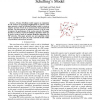49 search results - page 1 / 10 » Creating an adaptive network of hubs using Schelling's model |
CACM
2006
13 years 5 months ago
2006
Thomas Schelling's model suggests an explanation for the existence of segregated neighborhoods in America. This paper presents a study on utilizing Schelling's model to c...
CSUR
1999
13 years 5 months ago
1999
The Web can be naturally modeled as a directed graph, consisting of a set of abstract nodes (the pages) joined by directional edges (the hyperlinks). Hyperlinks encode a considerab...
WSC
2008
13 years 7 months ago
2008
Recent research has shown that while many complex networks follow a power-law distribution for their node degrees, it is not sufficient to model these networks based only on their...
JUCS
2010
13 years 7 days ago
2010
Abstract: One of the difficulties that self-directed learners face on their learning process is choosing the right learning resources. One of the goals of adaptive educational syst...
ISCAS
2002
IEEE
13 years 10 months ago
2002
IEEE
We have implemented an aspect of learning and memory in the nervous system using analog electronics. Using a simple synaptic circuit we realize networks with Hebbian type adaptati...

